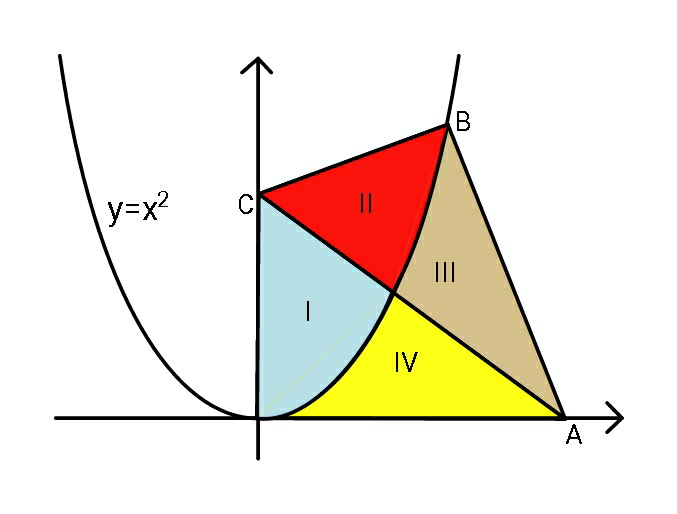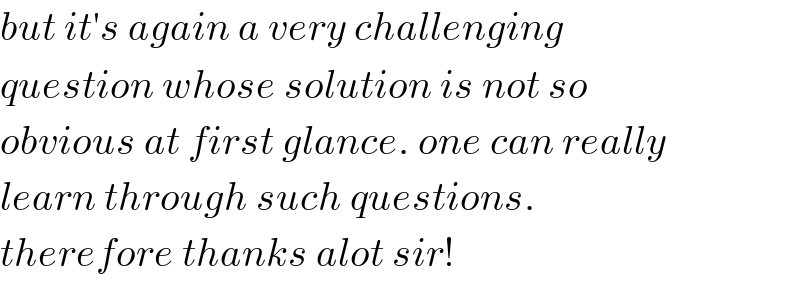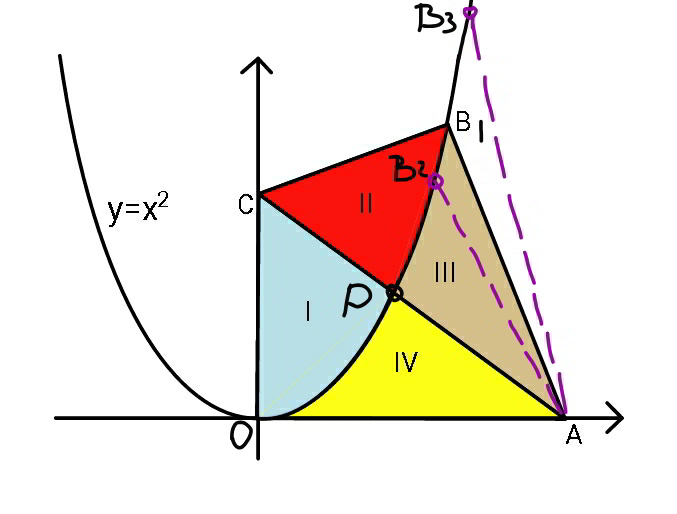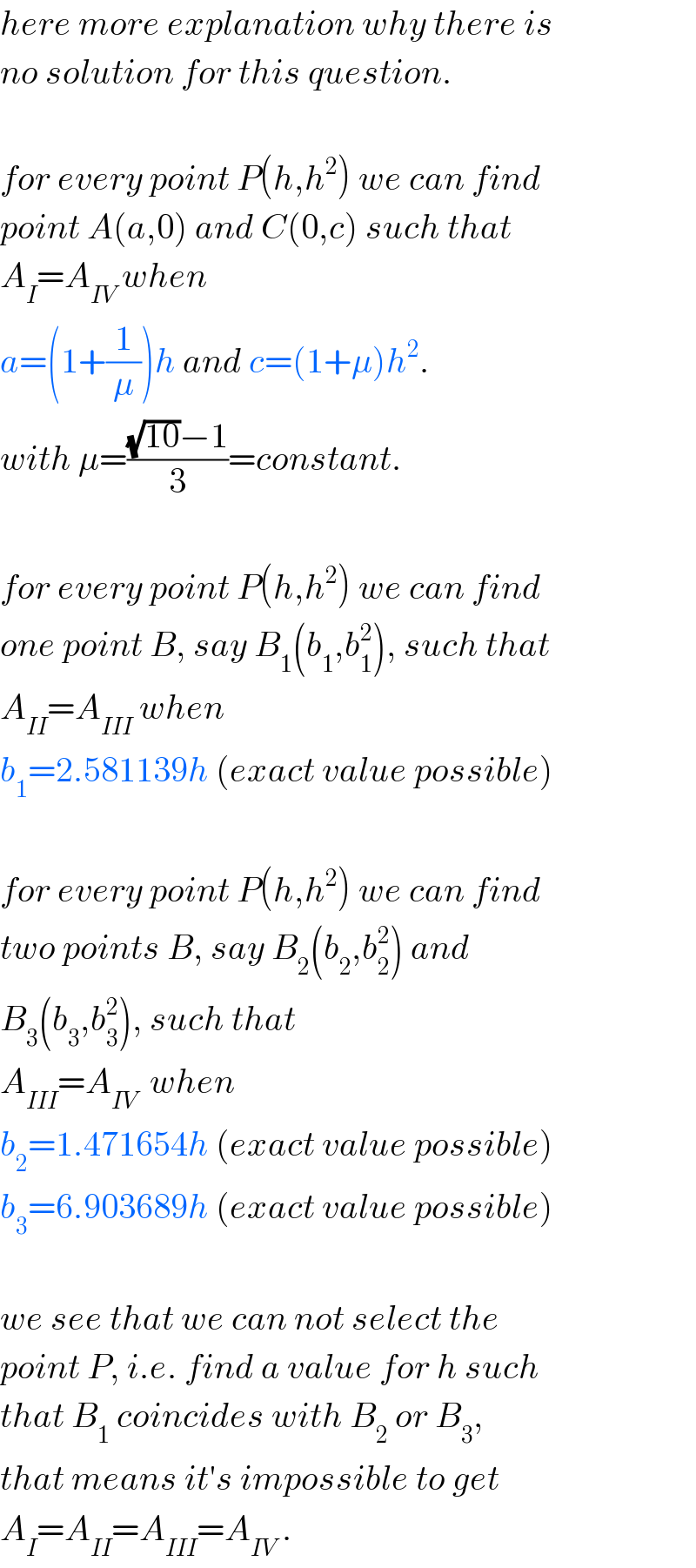Question Number 79697 by ajfour last updated on 27/Jan/20

Commented by ajfour last updated on 27/Jan/20

$${Find}\:{coordinates}\:{of}\:{A},{B},{C}\:{if} \\ $$$${each}\:{coloured}\:{regions}\:{I}\rightarrow{IV} \\ $$$${have}\:{the}\:{same}\:{area}. \\ $$
Answered by ajfour last updated on 27/Jan/20

$${let}\:\:{A}\left({a},\mathrm{0}\right)\:,\:{B}\left({b},{b}^{\mathrm{2}} \right)\:,\:{C}\left(\mathrm{0},{c}\right) \\ $$$${eq}.\:{of}\:{AC}\:{is}\:\:\:\:{y}=−\frac{{c}}{{a}}{x}+{c} \\ $$$${intersection}\:{with}\:{parabola}\:{say} \\ $$$${at}\:{P}\left({h},{h}^{\mathrm{2}} \right). \\ $$$$\:\:{h}^{\mathrm{2}} +\frac{{ch}}{{a}}={c} \\ $$$${h}^{\mathrm{2}} +\frac{{ch}}{{a}}−{c}=\mathrm{0} \\ $$$${h}=−\frac{{c}}{{a}}+\sqrt{\frac{{c}^{\mathrm{2}} }{{a}^{\mathrm{2}} }+{c}} \\ $$$${Area}\:{A}_{\mathrm{4}} =\frac{{h}^{\mathrm{3}} }{\mathrm{3}}+\frac{{h}^{\mathrm{2}} \left({a}−{h}\right)}{\mathrm{2}}\:\:\:\:\:….\left({i}\right) \\ $$$${A}_{\mathrm{1}} =\frac{{h}}{\mathrm{2}}\left({h}^{\mathrm{2}} +{c}\right)−\frac{{h}^{\mathrm{3}} }{\mathrm{3}}\:\:\:\:\:\:\:\:\:\:\:\:….\left({ii}\right) \\ $$$${A}_{\mathrm{1}} +{A}_{\mathrm{2}} =\frac{{b}}{\mathrm{2}}\left({c}+{b}^{\mathrm{2}} \right)−\frac{{b}^{\mathrm{3}} }{\mathrm{3}}\:\:\:\:….\left({iii}\right) \\ $$$${A}_{\mathrm{3}} +{A}_{\mathrm{4}} =\frac{{b}^{\mathrm{3}} }{\mathrm{3}}+\frac{{b}^{\mathrm{2}} \left({a}−{b}\right)}{\mathrm{2}}\:\:\:\:\:\:….\left({iv}\right) \\ $$$$\_\_\_\_\_\_\_\_\_\_\_\_\_\_\_\_\_\_\_\_\_\_\_\_\_ \\ $$$${c}={ab}−\frac{\mathrm{2}{b}^{\mathrm{2}} }{\mathrm{3}} \\ $$$${c}=\frac{{ah}}{\mathrm{2}}−\frac{{h}^{\mathrm{2}} }{\mathrm{3}} \\ $$$${c}=\frac{{h}^{\mathrm{2}} }{\mathrm{1}−\frac{{h}}{{a}}} \\ $$$${c}=\frac{\mathrm{2}{ah}^{\mathrm{2}} −{ab}^{\mathrm{2}} }{{b}−\mathrm{2}{h}} \\ $$$$\Rightarrow\:\:\:\frac{{ah}}{\mathrm{2}}−\frac{{h}^{\mathrm{2}} }{\mathrm{3}}=\frac{{h}^{\mathrm{2}} }{\mathrm{1}−\frac{{h}}{{a}}} \\ $$$$\Rightarrow\:\:\:\left(\mathrm{1}−\frac{{h}}{{a}}\right)\left(\frac{{a}}{\mathrm{2}}−\frac{{h}}{\mathrm{3}}\right)={h} \\ $$$$\frac{{h}^{\mathrm{2}} }{\mathrm{3}{a}}−\frac{\mathrm{11}{h}}{\mathrm{6}}+\frac{{a}}{\mathrm{2}}=\mathrm{0} \\ $$$$\mathrm{2}{h}^{\mathrm{2}} −\mathrm{11}{ah}+\mathrm{3}{a}^{\mathrm{2}} =\mathrm{0} \\ $$$$\frac{{h}}{{a}}=\frac{\mathrm{11}}{\mathrm{4}}−\frac{\sqrt{\mathrm{109}}}{\mathrm{4}}\:=\:{k} \\ $$$$\Rightarrow\:\:{h}={ka} \\ $$$${c}=\frac{{h}^{\mathrm{2}} }{\mathrm{1}−\frac{{h}}{{a}}}\:=\:\frac{{k}^{\mathrm{2}} {a}^{\mathrm{2}} }{\mathrm{1}−{k}} \\ $$$${c}=\frac{\mathrm{2}{ah}^{\mathrm{2}} −{ab}^{\mathrm{2}} }{{b}−\mathrm{2}{h}} \\ $$$$\Rightarrow\:\: \\ $$$$\frac{{k}^{\mathrm{2}} {a}^{\mathrm{2}} }{\mathrm{1}−{k}}=\frac{\mathrm{2}{k}^{\mathrm{2}} {a}^{\mathrm{3}} −{ab}^{\mathrm{2}} }{{b}−\mathrm{2}{ka}} \\ $$$$\Rightarrow\:\:\frac{{k}^{\mathrm{2}} {a}}{\mathrm{1}−{k}}=\frac{\mathrm{2}{k}^{\mathrm{2}} {a}^{\mathrm{2}} −{b}^{\mathrm{2}} }{{b}−\mathrm{2}{ka}} \\ $$$$\left(\frac{{k}^{\mathrm{2}} }{\mathrm{1}−{k}}\right)\left(\frac{{b}}{{a}}−\mathrm{2}{k}\right)=\mathrm{2}{k}^{\mathrm{2}} −\left(\frac{{b}}{{a}}\right)^{\mathrm{2}} \\ $$$$\left(\frac{{b}}{{a}}\right)^{\mathrm{2}} +\left(\frac{{k}^{\mathrm{2}} }{\mathrm{1}−{k}}\right)\frac{{b}}{{a}}−\frac{\mathrm{2}{k}^{\mathrm{2}} }{\mathrm{1}−{k}}=\mathrm{0}\:\:..\left({I}\right) \\ $$$${c}={ab}−\frac{\mathrm{2}{b}^{\mathrm{2}} }{\mathrm{3}} \\ $$$$\Rightarrow\:\:\:\frac{{k}^{\mathrm{2}} {a}^{\mathrm{2}} }{\mathrm{1}−{k}}={ab}−\frac{\mathrm{2}{b}^{\mathrm{2}} }{\mathrm{3}} \\ $$$$\frac{{k}^{\mathrm{2}} }{\mathrm{1}−{k}}=\frac{{b}}{{a}}−\frac{\mathrm{2}}{\mathrm{3}}\left(\frac{{b}}{{a}}\right)^{\mathrm{2}} \:\:\: \\ $$$$\left(\frac{{b}}{{a}}\right)^{\mathrm{2}} −\frac{\mathrm{3}}{\mathrm{2}}\left(\frac{{b}}{{a}}\right)+\frac{\mathrm{3}{k}^{\mathrm{2}} }{\mathrm{2}\left(\mathrm{1}−{k}\right)}\:=\:\mathrm{0}\: \\ $$$$\:\:\:\:\:\:\:\:\:\:\:\:\:\:\:\:\:\:\:\:\:\:\:\:\:\:\:\:\:\:\:\:\:\:\:\:\:\:\:\:\:\:\:\:\:\:\:\:\:\:…..\left({II}\right) \\ $$$$…. \\ $$
Commented by ajfour last updated on 27/Jan/20

$${I}\:{just}\:{have}\:{to}\:{check},\:{seems} \\ $$$${sure},\:{that}\:{they}'{ll}\:{conflict}.. \\ $$
Answered by mr W last updated on 28/Jan/20

$${A}\left({a},\mathrm{0}\right) \\ $$$${C}\left(\mathrm{0},{c}\right) \\ $$$${B}\left({b},{b}^{\mathrm{2}} \right) \\ $$$${intersection}\:{of}\:{AC}\:{with}\:{parabola}\:{at} \\ $$$${P}\left({h},{h}^{\mathrm{2}} \right) \\ $$$${let}\:{eqn}.\:{of}\:{AC}\:{be}\:{y}={h}^{\mathrm{2}} −{m}\left({x}−{h}\right) \\ $$$$\mathrm{0}={h}^{\mathrm{2}} −{m}\left({a}−{h}\right) \\ $$$$\Rightarrow{a}=\frac{{h}^{\mathrm{2}} }{{m}}+{h} \\ $$$${c}={h}^{\mathrm{2}} −{m}\left(\mathrm{0}−{h}\right) \\ $$$$\Rightarrow{c}={h}^{\mathrm{2}} +{mh} \\ $$$${A}_{{IV}} =\frac{{h}^{\mathrm{3}} }{\mathrm{3}}+\frac{{h}^{\mathrm{2}} \left({a}−{h}\right)}{\mathrm{2}}=\frac{{h}^{\mathrm{3}} }{\mathrm{3}}+\frac{{h}^{\mathrm{4}} }{\mathrm{2}{m}}={h}^{\mathrm{3}} \left(\frac{\mathrm{1}}{\mathrm{3}}+\frac{{h}}{\mathrm{2}{m}}\right) \\ $$$${A}_{{I}} =\frac{\mathrm{2}{h}^{\mathrm{3}} }{\mathrm{3}}+\frac{{h}\left({c}−{h}^{\mathrm{2}} \right)}{\mathrm{2}}=\frac{\mathrm{2}{h}^{\mathrm{3}} }{\mathrm{3}}+\frac{{mh}^{\mathrm{2}} }{\mathrm{2}}={h}^{\mathrm{2}} \left(\frac{\mathrm{2}{h}}{\mathrm{3}}+\frac{{m}}{\mathrm{2}}\right) \\ $$$${A}_{{I}} ={A}_{{IV}} \\ $$$${h}^{\mathrm{3}} \left(\frac{\mathrm{1}}{\mathrm{3}}+\frac{{h}}{\mathrm{2}{m}}\right)={h}^{\mathrm{2}} \left(\frac{\mathrm{2}{h}}{\mathrm{3}}+\frac{{m}}{\mathrm{2}}\right) \\ $$$$ \\ $$$$\Rightarrow\mathrm{3}{m}^{\mathrm{2}} +\mathrm{2}{hm}−\mathrm{3}{h}^{\mathrm{2}} =\mathrm{0}\:\:\:…\left({i}\right) \\ $$$${we}\:{get} \\ $$$$\Rightarrow{m}=\frac{\left(\sqrt{\mathrm{10}}−\mathrm{1}\right){h}}{\mathrm{3}}=\mu{h}\:{with}\:\mu=\frac{\sqrt{\mathrm{10}}−\mathrm{1}}{\mathrm{3}} \\ $$$${A}_{{III}+{IV}} =\frac{{b}^{\mathrm{3}} }{\mathrm{3}}+\frac{{b}^{\mathrm{2}} \left({a}−{b}\right)}{\mathrm{2}}=\frac{{b}^{\mathrm{3}} }{\mathrm{3}}+\frac{{b}^{\mathrm{2}} \left(\frac{{h}^{\mathrm{2}} }{{m}}+{h}−{b}\right)}{\mathrm{2}}=\frac{{b}^{\mathrm{2}} \left({h}+{m}\right){h}}{\mathrm{2}{m}}−\frac{{b}^{\mathrm{3}} }{\mathrm{6}} \\ $$$${A}_{{I}+{II}} =\frac{\mathrm{2}{b}^{\mathrm{3}} }{\mathrm{3}}−\frac{{b}\left({b}^{\mathrm{2}} −{c}\right)}{\mathrm{2}}=\frac{\mathrm{2}{b}^{\mathrm{3}} }{\mathrm{3}}−\frac{{b}\left({b}^{\mathrm{2}} −{h}^{\mathrm{2}} −{mh}\right)}{\mathrm{2}} \\ $$$$ \\ $$$${A}_{{I}+{II}} ={A}_{{III}+{IV}} \\ $$$$\frac{\mathrm{2}{b}^{\mathrm{3}} }{\mathrm{3}}−\frac{{b}\left({b}^{\mathrm{2}} −{h}^{\mathrm{2}} −{mh}\right)}{\mathrm{2}}=\frac{{b}^{\mathrm{2}} \left({h}+{m}\right){h}}{\mathrm{2}{m}}−\frac{{b}^{\mathrm{3}} }{\mathrm{6}} \\ $$$$\Rightarrow\mathrm{2}{mb}^{\mathrm{2}} −\mathrm{3}{h}\left({h}+{m}\right){b}+\mathrm{3}{hm}\left({h}+{m}\right)=\mathrm{0}\:\:\:…\left({ii}\right) \\ $$$${we}\:{get} \\ $$$$\Rightarrow{b}=\frac{\mathrm{3}{h}\left({h}+{m}\right)+\sqrt{\mathrm{3}{h}\left({h}+{m}\right)\left(\mathrm{3}{h}^{\mathrm{2}} +\mathrm{3}{hm}−\mathrm{8}{m}^{\mathrm{2}} \right)}}{\mathrm{4}{m}} \\ $$$$\Rightarrow\frac{{b}}{{h}}=\frac{\mathrm{3}\left(\mathrm{1}+\mu\right)+\sqrt{\mathrm{3}\left(\mathrm{1}+\mu\right)\left(\mathrm{3}+\mathrm{3}\mu−\mathrm{8}\mu^{\mathrm{2}} \right)}}{\mathrm{4}\mu} \\ $$$$\Rightarrow\frac{{b}}{{h}}=\mathrm{1}+\frac{\sqrt{\mathrm{10}}}{\mathrm{2}}\approx\mathrm{2}.\mathrm{581139} \\ $$$$ \\ $$$${A}_{{III}} ={A}_{{IV}} \:\Rightarrow\:{A}_{{III}+{IV}} =\mathrm{2}{A}_{{IV}} \\ $$$$\frac{{b}^{\mathrm{2}} \left({h}+{m}\right){h}}{\mathrm{2}{m}}−\frac{{b}^{\mathrm{3}} }{\mathrm{6}}=\mathrm{2}{h}^{\mathrm{3}} \left(\frac{\mathrm{1}}{\mathrm{3}}+\frac{{h}}{\mathrm{2}{m}}\right) \\ $$$$\Rightarrow{mb}^{\mathrm{3}} −\mathrm{3}{h}\left({h}+{m}\right){b}^{\mathrm{2}} +\mathrm{2}{h}^{\mathrm{3}} \left(\mathrm{2}{m}+\mathrm{3}{h}\right)=\mathrm{0}\:\:\:…\left({iii}\right) \\ $$$$\Rightarrow\left(\frac{{b}}{{h}}\right)^{\mathrm{3}} −\mathrm{3}\left(\mathrm{1}+\frac{\mathrm{1}}{\mu}\right)\left(\frac{{b}}{{h}}\right)^{\mathrm{2}} +\mathrm{2}\left(\mathrm{2}+\frac{\mathrm{3}}{\mu}\right)=\mathrm{0} \\ $$$$\Rightarrow\left(\frac{{b}}{{h}}\right)^{\mathrm{3}} −\left(\mathrm{4}+\sqrt{\mathrm{10}}\right)\left(\frac{{b}}{{h}}\right)^{\mathrm{2}} +\mathrm{2}\left(\mathrm{3}+\sqrt{\mathrm{10}}\right)=\mathrm{0} \\ $$$${we}\:{get} \\ $$$$\Rightarrow\frac{{b}}{{h}}=\:\left(\mathrm{3}\:{solutions},\:{too}\:{long}\:{to}\:{write}\right) \\ $$$$\Rightarrow\frac{{b}}{{h}}\approx−\mathrm{1}.\mathrm{213066},\:\mathrm{1}.\mathrm{471654},\:\mathrm{6}.\mathrm{903689} \\ $$$$ \\ $$$${since}\:{the}\:{solution}\:{for}\:{b}\:{from}\:\left({ii}\right)\:{is} \\ $$$${in}\:{contradiction}\:{with}\:{solutions}\:{from} \\ $$$$\left({iii}\right),\:{we}\:{must}\:{conclude}\:{that}\:{the} \\ $$$${question}\:{has}\:{no}\:{solution},\:{i}.{e}.\:{there} \\ $$$${are}\:{no}\:{points}\:{A},{B},{C}\:\:{which}\:{fulfill}\: \\ $$$${A}_{{I}} ={A}_{{II}} ={A}_{{III}} ={A}_{{IV}} . \\ $$
Commented by john santu last updated on 27/Jan/20

$$\mathrm{AC}\::\:\mathrm{cx}\:+\:\mathrm{ay}\:=\:\mathrm{ac}\: \\ $$
Commented by mr W last updated on 28/Jan/20
![for AC i use the equation in form of y=h^2 −m(x−h). it goes through point P(h,h^2 ) [the same as D(d,d^2 ) in your workings] and has the inclination −m. such that A_I =A_(IV) we have m=((((√(10))−1)h)/3).](https://www.tinkutara.com/question/Q79769.png)
$${for}\:{AC}\:{i}\:{use}\:{the}\:{equation}\:{in}\:{form}\:{of} \\ $$$${y}={h}^{\mathrm{2}} −{m}\left({x}−{h}\right). \\ $$$${it}\:{goes}\:{through}\:{point}\:{P}\left({h},{h}^{\mathrm{2}} \right)\:\left[{the}\:{same}\right. \\ $$$$\left.{as}\:{D}\left({d},{d}^{\mathrm{2}} \right)\:{in}\:{your}\:{workings}\right]\:{and}\:{has} \\ $$$${the}\:{inclination}\:−{m}. \\ $$$${such}\:{that}\:{A}_{{I}} ={A}_{{IV}} \:{we}\:{have} \\ $$$${m}=\frac{\left(\sqrt{\mathrm{10}}−\mathrm{1}\right){h}}{\mathrm{3}}. \\ $$
Commented by ajfour last updated on 28/Jan/20

$${unfortunately}\:{a}\:{no}\:{solution} \\ $$$${question},\:{thanks}\:{for} \\ $$$${attempting}\:{sir}. \\ $$
Commented by mr W last updated on 28/Jan/20

$${but}\:{it}'{s}\:{again}\:{a}\:{very}\:{challenging}\: \\ $$$${question}\:{whose}\:{solution}\:{is}\:{not}\:{so} \\ $$$${obvious}\:{at}\:{first}\:{glance}.\:{one}\:{can}\:{really} \\ $$$${learn}\:{through}\:{such}\:{questions}. \\ $$$${therefore}\:{thanks}\:{alot}\:{sir}! \\ $$
Commented by john santu last updated on 28/Jan/20

$$\mathrm{this}\:\mathrm{case}\:\mathrm{closed}? \\ $$
Commented by mr W last updated on 28/Jan/20

Commented by mr W last updated on 28/Jan/20

$${here}\:{more}\:{explanation}\:{why}\:{there}\:{is} \\ $$$${no}\:{solution}\:{for}\:{this}\:{question}. \\ $$$$ \\ $$$${for}\:{every}\:{point}\:{P}\left({h},{h}^{\mathrm{2}} \right)\:{we}\:{can}\:{find} \\ $$$${point}\:{A}\left({a},\mathrm{0}\right)\:{and}\:{C}\left(\mathrm{0},{c}\right)\:{such}\:{that} \\ $$$${A}_{{I}} ={A}_{{IV}} \:{when} \\ $$$${a}=\left(\mathrm{1}+\frac{\mathrm{1}}{\mu}\right){h}\:{and}\:{c}=\left(\mathrm{1}+\mu\right){h}^{\mathrm{2}} . \\ $$$${with}\:\mu=\frac{\sqrt{\mathrm{10}}−\mathrm{1}}{\mathrm{3}}={constant}. \\ $$$$ \\ $$$${for}\:{every}\:{point}\:{P}\left({h},{h}^{\mathrm{2}} \right)\:{we}\:{can}\:{find} \\ $$$${one}\:{point}\:{B},\:{say}\:{B}_{\mathrm{1}} \left({b}_{\mathrm{1}} ,{b}_{\mathrm{1}} ^{\mathrm{2}} \right),\:{such}\:{that} \\ $$$${A}_{{II}} ={A}_{{III}} \:{when} \\ $$$${b}_{\mathrm{1}} =\mathrm{2}.\mathrm{581139}{h}\:\left({exact}\:{value}\:{possible}\right) \\ $$$$ \\ $$$${for}\:{every}\:{point}\:{P}\left({h},{h}^{\mathrm{2}} \right)\:{we}\:{can}\:{find} \\ $$$${two}\:{points}\:{B},\:{say}\:{B}_{\mathrm{2}} \left({b}_{\mathrm{2}} ,{b}_{\mathrm{2}} ^{\mathrm{2}} \right)\:{and} \\ $$$${B}_{\mathrm{3}} \left({b}_{\mathrm{3}} ,{b}_{\mathrm{3}} ^{\mathrm{2}} \right),\:{such}\:{that} \\ $$$${A}_{{III}} ={A}_{{IV}} \:\:{when} \\ $$$${b}_{\mathrm{2}} =\mathrm{1}.\mathrm{471654}{h}\:\left({exact}\:{value}\:{possible}\right) \\ $$$${b}_{\mathrm{3}} =\mathrm{6}.\mathrm{903689}{h}\:\left({exact}\:{value}\:{possible}\right) \\ $$$$ \\ $$$${we}\:{see}\:{that}\:{we}\:{can}\:{not}\:{select}\:{the} \\ $$$${point}\:{P},\:{i}.{e}.\:{find}\:{a}\:{value}\:{for}\:{h}\:{such} \\ $$$${that}\:{B}_{\mathrm{1}} \:{coincides}\:{with}\:{B}_{\mathrm{2}} \:{or}\:{B}_{\mathrm{3}} , \\ $$$${that}\:{means}\:{it}'{s}\:{impossible}\:{to}\:{get} \\ $$$${A}_{{I}} ={A}_{{II}} ={A}_{{III}} ={A}_{{IV}} \:. \\ $$
Commented by mr W last updated on 28/Jan/20

$${to}\:{me}\:{the}\:{case}\:{is}\:{clear}\:{and}\:{closed}. \\ $$
